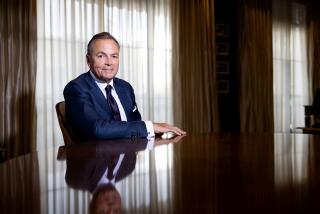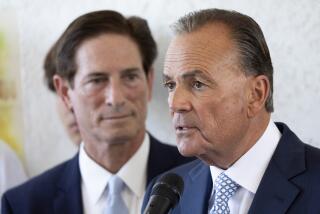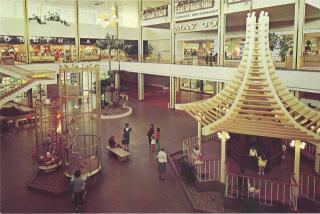Alternate reality
New Orleans — Multimillionare developer Rick Caruso is walking past the shops on Royal Street in the heart of the French Quarter, surveying the streetscape with all its architectural elegance and decay.
Little escapes the notice of the Los Angeles businessman: the ornately carved crown moldings, the wrought iron balconies, sizzling gas lanterns, cypress shutters, cracked sidewalks, leaning walls, bare wires. The place is beautiful but worn out. To Caruso, it looks like a dump.
“They certainly haven’t spent any money on maintenance,” he says. “I don’t see any reason to ever come back here again.”
As Caruso walks, his cellphone and BlackBerry buzz constantly with messages that tether him to Los Angeles. Mayor James Hahn wants to meet with him. So does City Councilman Antonio Villaraigosa, who wants Hahn’s job. A reporter calls to discuss his latest project, an outdoor shopping center in Glendale. His office is trying to reach Gov. Arnold Schwarzenegger, a close friend. The White House wants to know if he’s interested in a commission position. (He is, but only in his spare time.) His wife wants to talk to him about the Christmas lights on their Brentwood mansion.
Impeccably dressed in a $6,000 Brioni suit and square-toed Dolce & Gabbana oxfords, Caruso, appointed by Hahn to the Los Angeles Police Commission, takes calls and keeps moving. His entourage -- among them a former amusement park architect, a Hollywood-style marketing specialist and a financier -- are following close behind, watching their boss scrutinize the scenery while performing his daily ballet of multi-tasking.
At 45, Caruso is dashing, fabulously rich, politically connected and determined to reinvent one of the country’s most ubiquitous cultural icons -- the mall. He has more than $1 billion in projects in the works in California and half a dozen other malls completed , including the Grove, a wildly popular amusement park-like shopping center next to the Farmers Market at 3rd Street and Fairfax Avenue. Caruso fought, and won, a bitter $2-million battle in September to build a similar project on Brand Boulevard near the Glendale Galleria.
These days, he’s gearing up for another fight, this time to build an outdoor mall and residential complex at Santa Anita Park in Arcadia, not far from an enclosed mall owned by Westfield Group.
On a warm November afternoon, Caruso and the top members of his staff flew by private jet to New Orleans specifically to get ideas for the developer’s Santa Anita project, which he plans to model after the French Quarter. Caruso loves the concept of incorporating the charm of old buildings into his new developments and he has a great appreciation for vintage architectural details, notably stained glass and antique fountains. But it’s clear as he walks down Royal Street that he doesn’t like the real old buildings, with their musty odors, battered floors and peeling paint. (He later declares that Bourbon Street “smells like my college fraternity house.”)
Admirers and critics
To Caruso, who grew up rich in Los Angeles, shabby is certainly not chic. Forget about weathered and funky. He wants things neat, clean and new. And to many people, there’s nothing wrong with that.
His vision of his so-called “lifestyle center” is becoming increasingly popular among developers, who are building faux street-scene-type malls all over the country. The Grove, which launched Caruso’s career as one of the most influential outdoor mall builders in America, was successful from the day it opened nearly 2 1/2 years ago.
“As the world becomes more complicated and people have less time in their lives, these kinds of places become retreats for people,” says Caruso, whose father founded Dollar Rent a Car, giving him the seed money he needed to start his development firm. “The property has the ability to transport people to a better time.”
With the help of Hollywood set designers and a team of architects, the developer has mastered the art of making things deliberately fake. His malls are facsimiles of city life, seeking to capture the well-moneyed baby boomers’ gauzy memories of their youth.
But Caruso’s is a style not everyone likes, whether it’s his malls, his politics or his personality.
The developer -- who walks with a swagger and talks with a voice that cuts through a crowd -- has been called arrogant and cavalierly confrontational. His critics complain that his projects are as hollow as the facades on a Hollywood set, that he replicates the past while discarding the grittiness that gives old buildings their soul.
“He is a very slick, smart, clever guy,” says Arlene Vidor, the president of the Glendale Historical Society, which is fighting Caruso on his efforts to demolish an old fire station and another building to make way for his Brand Boulevard development.
“He has learned how to ply his trade very well and very successfully. I admire him for that. But I just don’t sign on to his vision of urban development. Real organic redevelopment of a city environment should be our goal, not these false environments that look like a Disney back lot.”
His supporters -- among them some of the city’s most powerful people -- see him as a visionary. Maybe his developments are a little twee, but his fans say his designs are far more imaginative than the boxy indoor malls.
“He’s innovative,” says Schwarzenegger, who met Caruso years ago at their children’s school. “I think the world of him. He loves L.A. He’ll do anything for the mayor and the community. He’s doing some daring projects and fighting the big mall operators.”
Mayor Hahn, who considers Caruso a close advisor, says “it’s fantastic in terms of what he’s been able to accomplish with his malls. At first everyone was a little concerned because they love the charm of the old Farmers Market and they thought the Grove would have a negative impact on it.
“But it’s been a happy coexistence. Rick did his homework and his research.”
For Caruso, style is the substance of the matter.
“It’s a thousand different things you notice but you couldn’t tell what it is,” he says. “It’s the scale of buildings and the width of the street. It’s the rhythm of the trees and the lampposts. It’s the eye candy that your brain picks up but you can’t really say what makes a difference.”
Arcadia’s French Quarter
As he walks through the French Quarter, Caruso hears flowing water, a favorite sound. He steps into a dark alley that leads to a hidden sunlit courtyard, where he spots an urn-shaped fountain spitting cool water into a basin.
“Baschar, come see this,” Caruso calls to architect Baschar Hraki, who’s toting a large digital camera. “This is what I want for Santa Anita.” Then he looks around. The buildings that surround the courtyard are in sorry shape. The windows are broken and the brick walls are cracked.
Caruso is dismayed. “It’s not what I expected,” he says. He warns his staff to watch their step on the broken pavement.
“He has unbelievably high standards,” says his marketing director Linda Berman, who worked at MGM. “He’s not afraid to let you know how he feels. What you see is what you get.”
After two hours of walking around the French Quarter, snapping pictures of building facades and courtyards, Caruso’s driver offers to take the group to another location, the Garden District. The group piles into two SUVs and heads outside the French Quarter, traveling through downtrodden neighborhoods into one of the finest residential areas in New Orleans.
Caruso asks the driver to pull over on St. Charles Avenue. He is in awe of a white mansion, built at the turn of the 19th century and modeled after a wedding cake. He gets out of the SUV and walks to the gate, staring at the structure, almost in disbelief. Although it’s now after dark, Caruso decides he wants to stroll the street, to gaze at the other huge houses, gorgeous Colonials and Victorians.
“Could you imagine growing up in this neighborhood?” he asks.
Suddenly New Orleans doesn’t look so bad after all.
Caruso is surrounded again by his entourage, snapping pictures in the dark and trying to keep pace as their boss walks down Rose Avenue. The group looks a little imposing, like suited-up FBI agents on a mission.
“People are probably looking out their windows, wondering ‘who are those people?’ ” Caruso jokes. “Hello, we’ve invaded from Los Angeles.”
Throughout the 1990s, before Caruso was developing malls, mostly he was building industrial complexes, square structures that bored him because they required little creativity. He wanted something more challenging, something that would let him display his elan.
He knew just the man who was willing to give him a chance.
A powerful friend
Near the end of his life five years ago, Los Angeles City Councilman John Ferraro -- who had been friends for years with Caruso’s father -- urged his council colleagues to allow the young millionaire to build a lavish open-air mall next to the old Farmers Market.
Ferraro, who had come to regard Caruso as a son, believed the new shopping center would be “a work of art,” drawing tens of thousands of people into the heart of his district each year. Though he was gravely ill, the aging councilman arrived in chambers by wheelchair the February day that Caruso sought permission to break ground on the Grove.
The developer appeared confident as he sat at the table before the city lawmakers. On the sidelines, the dowagers on Ferraro’s staff whispered about how cute he was and called him “Ricky.”
At first, the plans seemed like a youthful folly. The mall would resemble an old Italian villa, like the ones Caruso visited with his family during his youth. There would be a trolley, old-fashioned streetlights cast in iron and a sound system that bellowed Frank Sinatra tunes (Caruso’s favorite). There would be restaurants, a bookstore, a movie theater and plenty of upscale chain stores.
The project would include a $2-million fountain, cobblestone walkways and bronze sculptures. People could lounge in the sun on a plot of grass, and a clock tower would ring every half-hour.
Wowed by Caruso and unwilling to go against Ferraro’s wishes, the council approved the project, voting 12-1. No one from the community was there to complain, even though many there worried about its effect on the area. Rita Walters cast the sole vote against the plan, saying she thought the shopping center would cause gridlock in the surrounding neighborhood.
Indeed, it has caused a lot of traffic problems, but that’s because it’s hugely successful. The old Farmers Market is thriving and the movie theater is among the most popular in America.
And Caruso has never looked back.
A lavish lifestyle
The past three years have been a whirlwind for the developer, who has tripled the number of people on his staff. His malls include the Commons at Calabasas, the Promenade at Westlake, the Village at Moorpark and the Encino Marketplace. In addition to Arcadia and Glendale, he is planning to build open-air shopping centers on the edge of the San Francisco Bay, in Playa Vista, at Thousand Oaks’ Civic Center and in Marina del Rey.
As he builds his empire, Caruso is also upgrading his already upscale personal style.
Caruso lives in Brentwood, where he and his wife, Tina, custom-built a 20,000-square-foot Mediterranean style house to share with their four children. The family has a staff of 10, including a house manager, nannies, maids and a security detail that works around the clock.
He collects watches, Rolexes and Cartiers. (When asked how many, he’s demure. “You’re going to make me sound like a jerk,” he says.)
Caruso has an armada of cars, including a Rolls-Royce and a Bentley. He owns a yacht, which he docks in Newport Beach at his second house. He usually travels by private jet.
He raised $1 million during a lavish dinner he hosted at his house for President Bush’s re-election campaign. Ditto for Schwarzenegger’s bid in the recall election. And on Tuesday he said that he would finance a petition drive to put a half-cent sales tax on the city ballot in May to pay for more police if the City Council refuses to act.
Caruso has also held several fundraisers for Hahn, including one on his yacht. Earlier this month, he hosted a dinner to welcome Kenneth Starr, who took over as head of Pepperdine’s law school. (Caruso received his law degree from Pepperdine after completing business school at USC.) He has served for many years on two powerful city commissions that monitor the Department of Water and Power and the Los Angeles Police Department.
One thing is clear: He is not afraid of confrontation.
When in his role as head of the Police Commission two years ago he was given the politically sensitive task of firing then-Chief Bernard C. Parks, at Hahn’s urging, he didn’t shy away from the fight, though he claims he got threats from Parks supporters. And when he decided that he wanted to build the mall in Glendale earlier this year, he welcomed the chance to take the matter to the voters -- pouring $2 million into the campaign to win the election.
Vidor, of the Glendale Historical Society, says going up against him was “like dealing with a cult.”
“People believed that he could do no wrong,” she says. “How can you challenge that?”
Caruso says he’s hoping that his new developments in Glendale and Arcadia will be completely different -- but equally as stylistically elaborate -- as the Grove.
“We want to do what we do really well,” he says. “What we are building are downtowns. It’s not just the big ideas, it’s also the little ideas that matter.”
Former Los Angeles Mayor Richard Riordan opposed Caruso’s effort to remove Parks as chief, but says he admires the developer’s business sense.
“His father is a wealthy man, so he came to it the easy way,” Riordan says. “But he never let that make him lazy.
“I think he’s ready to take over Los Angeles.”
More to Read
Sign up for Essential California
The most important California stories and recommendations in your inbox every morning.
You may occasionally receive promotional content from the Los Angeles Times.










